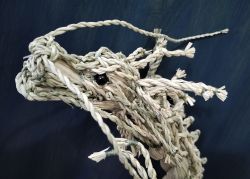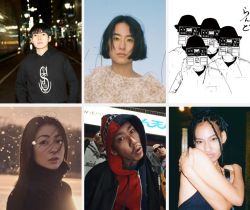
September 7, 2011
Taro Okamoto
The second part of the 100th anniversary show honors the legacy of an artistic phenomenon
By Metropolis
Originally published on metropolis.co.jp on September 2011



Visiting the Taro Okamoto Museum of Art is always a fascinating experience. Located in Kawasaki’s heavily-wooded Ikuta Ryokuchi Park, the specially designed building seems like a cross between a freemason hall on acid and the cult centre of a cross-eyed messiah.
Strange as this may sound, it is only to be expected. During his early life, when he was studying art in Paris, Okamoto became fascinated by esotericism and occultism. He attended meetings of the College of Sociology, a group of intellectuals interested in ritualism led by Georges Bataille, and was also initiated into Acéphale, a mystical secret society.
Later, following his return to Japan, Okamoto became a dominating figure on the Japanese art scene. This was only partly due to his art. More important was the French intellectualism that he brought back and adapted to local conditions, along with his mesmeric charisma and media-savvy persona, which allowed him to achieve cult status in the Japanese media.
The exhibition commemorates the 100th anniversary of Okamoto’s birth and is divided into two parts. The first part, which finished in July, focused on people who worked with Okamoto. The second part looks at his wider influence as an inspirational figure and cultural phenomenon.
The best way to approach this special exhibition is through the museum’s main permanent exhibition, where you can see a selection of some of the artist’s most impressive paintings and sculptures. These are brash, often anthropomorphic abstracts, many of which were influenced by his later interest in prehistoric Jomon period pottery and artifacts. This leads to the special exhibition, which is divided into several rooms opening onto a large hall dominated by “Alien named PAIRA” (1956), a large, inflated star with a giant eye that evokes the All-Seeing Eye, a common mystical symbol in freemasonry.
One of the rooms looks at Okamoto’s involvement in architecture, including his collaboration with Kenzo Tange for “Tower of the Sun,” the symbol of the 1970 Osaka Expo. Another room looks at “Taro Ai” (Taro Love) a photographic book by Japan’s most famous shutterbug, Akira Nobuyoshi.
Like Okamoto, Nobuyoshi has cultivated a strong public persona and has become famous as much for his image as his art. This suggests a degree of emulation in terms of showmanship. In the actual photos, Nobuyoshi uses Okamoto’s “Tower of the Sun” and other elements of Okamoto’s art in his usual, erotically tinged photos.
Surprisingly for an artist as influential as Okamoto, the exhibition has comparatively few paintings and sculptures by other artists. Those represented include Tadanori Yokoo and Shozo Kitadai. But their works are overshadowed by Ushio Shinohara’s vast, sprawling, anarchic canvas, “Taro Okamoto Working Outdoors—From Sunrise in Arizona to Sunset in Bermuda” (2000). The fact that most of these artworks include representations of Okamoto strengthens the somewhat cultish atmosphere of the exhibition.
Other rooms look at Okamoto’s role in the wider media, with clips of interviews and all 60 editions of Japanese Playboy in which he wrote a column answering readers’ questions on a wide variety of topics. To contrast the resulting implication of seediness, another room focuses on his scholarly and academic interests, with bookshelves crammed with the works of philosophers and intellectuals. These include Georges Bataille, the Jewish sociologist Marcel Mauss, who taught Okamoto in Paris, and the once anti-Semitic Romanian philosopher Mircea Eliade whose views had the profoundest impact on Okamoto’s own theories, according to the exhibition’s curator, Hidenori Sasaki.
The diverse elements in Okamoto’s mentality revealed by this show suggest that he was a very contradictory character. However, this was something entirely in keeping with his own philosophy, which emphasized contradiction and polarity as creative spiritual forces, rather than the dominant modernist values of logic and synthesis.
Taro Okamoto: The Man—The 100th Anniversary of His Birth runs until September 25 (listing).








